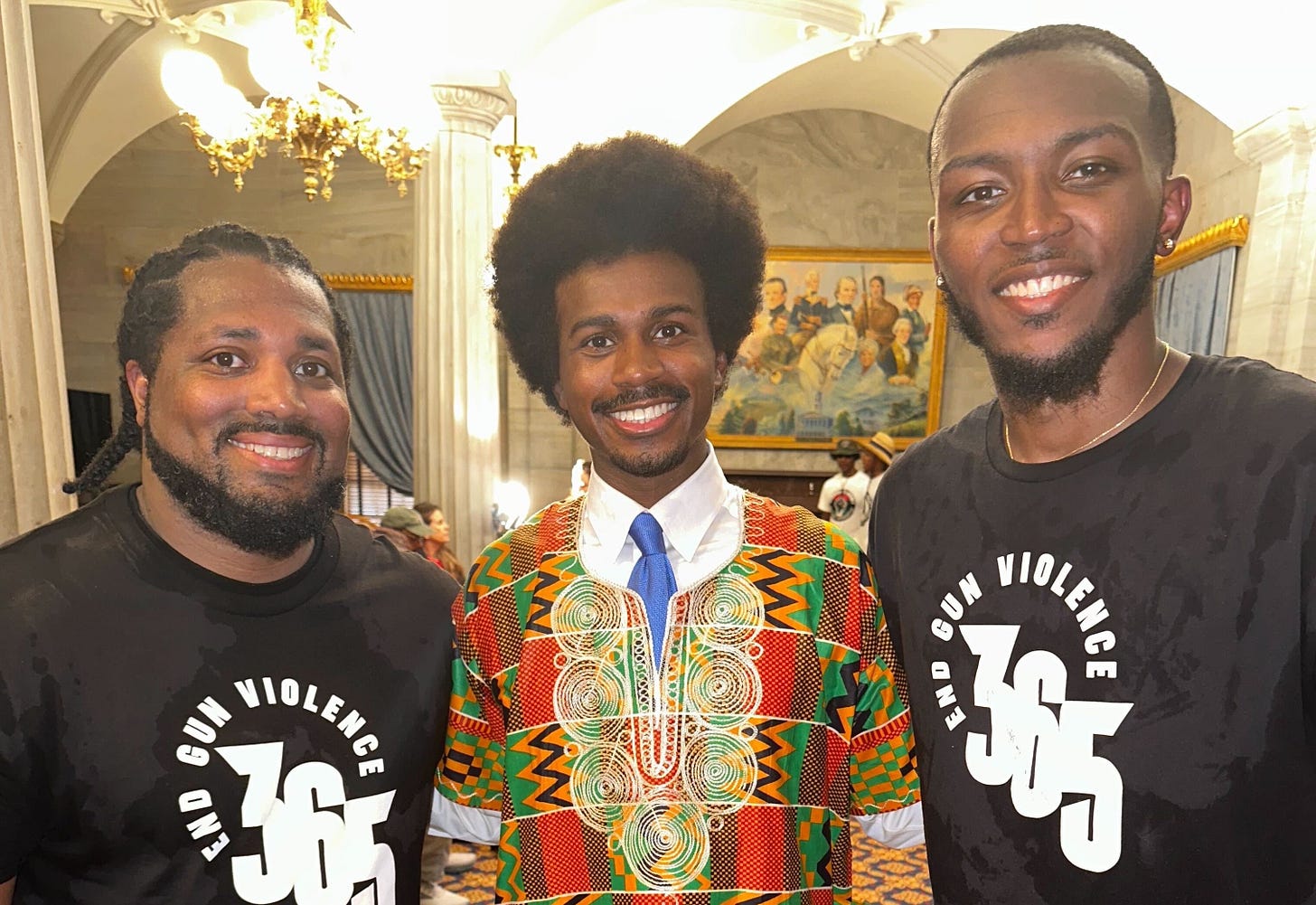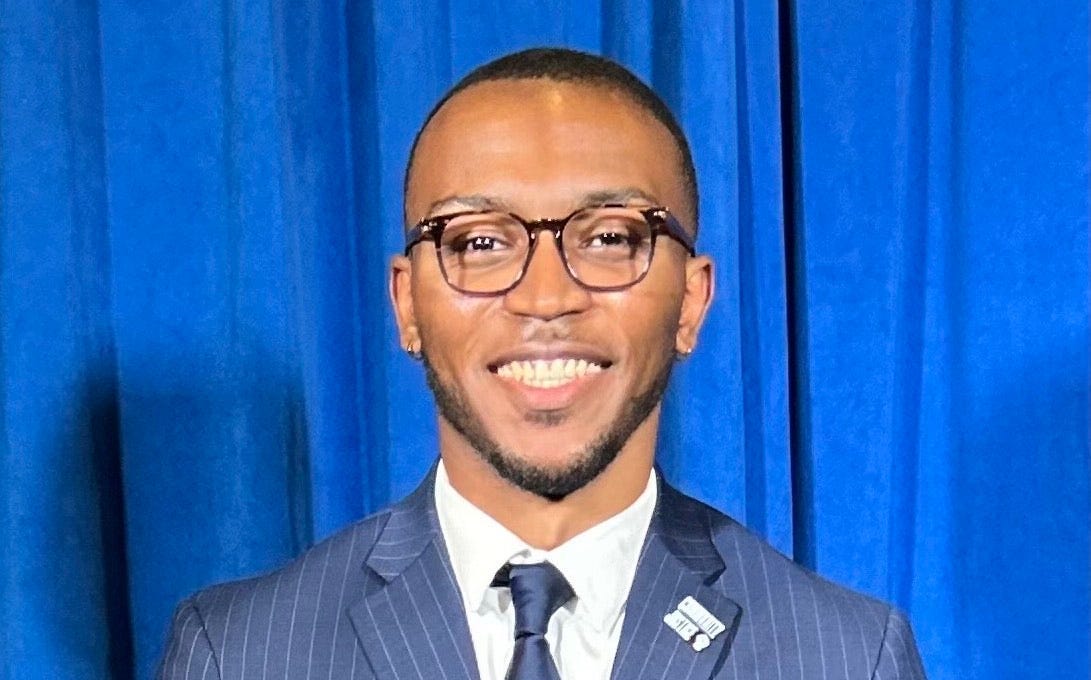ICYMI: Guns, Sports, and the Fight for Our Communities
Gun gestures on the field reflect the reality that many players grew up around

We recently received this excellent report from Brent Bailey, the Southeast Regional Advocacy Associate at Community Justice. In it, he elucidates the way sports and gun culture are often intertwined in the South; and the important work done by community organizers, and the NBA and NFL Players Coalitions, to combat that connection. In case you missed it, check out the article below.
Culture moves faster than policy. When the wrong message gets amplified, it can be harmful. But when we get it right — when we uplift the right messengers, fund community solutions, and push our leaders to act — we can change the narrative and the reality.
The Culture Is Watching: Guns, Sports, and the Fight for Our Communities
By: Brent Bailey
In the Southeast, culture isn’t just something we consume, it’s something we create. From music to food to sports, what happens here often sets the tone for the rest of the country. But lately, I’ve been thinking a lot about the weight of that influence — especially when it comes to guns.
As someone born and raised in Louisiana and now organizing across seven Southeastern states with Community Justice, I have spent the last few years working closely with individuals who are doing the hard work of preventing gun violence.
These are not just activists or advocates, they’re credible messengers — violence interrupters, outreach workers, and neighborhood leaders who build trust where institutions have failed and lives are on the line. They are also mothers and fathers, aunts and uncles, often carrying the weight of their own lived experiences with gun violence while fighting to keep someone else’s child alive. They don’t just show up for a job, they show up because their communities’ problems are personal.
Intentional investments work. In New Orleans, Congressman Troy Carter, Mayor LaToya Cantrell, and Health Department Director Jennifer Avegno spearheaded one of the nation’s steepest homicide reductions — murders are down roughly 39% year‑to‑date, and overall violent crime is among the top declines nationwide. Despite Governor Jeff Landry’s tough-on-crime rhetoric and public skepticism of the city’s crime data, these targeted strategies yielded real progress, enabling community groups like Ubuntu Village to scale up their Peace Ambassador program, offering culturally responsive interventions, conflict mediation, and wrap-around support to break cycles of violence.
L-R: Greg Jackson, Former Executive Director of Community Justice and Former Deputy Director of The White House Office of Gun Violence Prevention; Tennessee State Representative Justin Pearson; Brent Bailey (photo courtesy of author).
Local mayors have also stepped up in meaningful ways. In Birmingham, Alabama Mayor Randall Woodfin has emerged as one of the nation’s leading mayoral voices pushing for a ban on Glock switches — illegal conversion devices that turn handguns into fully automatic weapons and are increasingly used in neighborhood shootings. Newly elected Memphis, Tennessee Mayor Paul Young partnered with Shelby County Mayor Lee Harris to launch the Joint Office of Neighborhood Safety & Engagement, merging city and county violence‑prevention programs to curb gun violence and provide wrap‑around support services in the community.
They have made it clear: these aren’t just policy debates. These are survival issues in Black communities.
While CVI organizations and local leaders are working tirelessly to reduce violence, a different message about guns is playing out in stadiums, highlight reels, and social media feeds, and it’s coming from some of the most visible cultural figures in our region — athletes.
It’s impossible to ignore how every, recent, high-profile incident involving athletes using gun gestures has come from teams based in Southeastern states that have refused to pass meaningful gun safety legislation.
Ja Morant of the Memphis Grizzlies (Tennessee), Drake London of the Atlanta Falcons (Georgia), Kendric Rhymes of Southern University (Louisiana), and Kyren Lacy of LSU (Louisiana) all drew attention for on-field or off-field behavior involving gun symbolism or incidents related to actual firearms. These aren’t isolated moments, they’re increasingly common cultural flashpoints happening in states where lawmakers have done little to address gun violence, despite being some of the hardest hit.
And tragically, we must now speak of Kyren Lacy in the past tense. The former LSU standout recently died by suicide with a firearm. While the details of his legal case are still unfolding, it is impossible to ignore the role Louisiana’s media and criminal justice culture have played in shaping public perception.
Lacy’s mugshot was widely circulated in the press before due process could play out — a practice that’s legal in Louisiana, where mugshot laws often allow public shaming long before a fair trial begins. In a state that continues to stigmatize mental health and over-criminalize Black men, it’s not hard to see how that kind of spotlight can lead to devastating outcomes. The system didn’t protect him, it helped break him.
Some people dismiss these gestures and controversies as swagger or celebration. But let’s be real — when you mimic shooting a gun after a dunk or touchdown, you’re sending a message. And in a region where too many kids don’t make it to adulthood because of gun violence, that message lands hard.
As a counterpoint, consider Austin Reaves of the Los Angeles Lakers — a white athlete who has publicly rejected the “AR‑15” nickname, recognizing the sensitivities around gun violence in America. When athletes of all races grapple with these symbols, we must ask what the imagery reveals about our culture.
This isn’t about canceling athletes, it’s about context. Athletes — especially young Black men from the South — are under constant performance scrutiny while simultaneously expected to be role models. Rather than condemning them, we should be asking why the imagery of guns shows up so frequently in sports, and what that tells us about the culture these athletes come from.
The gestures we see on the field reflect the reality that many of these players grew up around. That’s precisely why CVI work is so critical. Many of the people doing this work have personally experienced it. For them, gun violence isn’t just statistics. It’s trauma, it’s grief, it’s a cousin buried too soon, or a best friend who never got to grow old. They’ve turned that pain into purpose. And they’re doing what policymakers and institutions have failed to do: stop violence before it starts.
We need to stop treating CVI as a side project. It should be at the forefront of every conversation about public safety.
These organizations are reducing harm, creating safer neighborhoods, and offering young people alternatives to violence. They’re also often operating with limited support and recognition, even though they’re the ones doing the most essential work.
Which brings us to leadership. In Louisiana, Attorney General Liz Murrill has prioritized a statewide anti-vaping campaign that not only misses the mark on urgent public safety issues, but also reflects a deeper exploitation of culture. Her campaign has leaned heavily on the visibility of LSU athletes, aligning them with conservative priorities through NIL deals that push anti-vaping messaging while ignoring the far more pressing issue of gun violence in the communities those athletes come from.
With May being Mental Health Awareness Month and June marking Gun Violence Prevention Awareness Month, I have to ask: Where’s the urgency for addressing gun violence? Where’s the investment in trauma-informed approaches and evidence-based prevention? If you care about mental health, you can’t ignore the toll gun violence takes on our communities, especially our young people.
Governor Jeff Landry ran on a tough-on-crime platform, but his administration has done little to back up that rhetoric with real, community-rooted solutions. Just this past year, he and Republican legislators failed to advance Senate Bill 203, introduced by Senator Royce Duplessis, which would have created a statewide Office of Violence Prevention — a measure that could’ve brought long-overdue infrastructure and strategy to reducing gun violence.
And when it came time for the people of Louisiana to weigh in, they rejected Landry’s so-called “tough-on-crime” agenda at the ballot box, voting down all of his proposed constitutional amendments, including one that would have allowed more teenagers to be charged and imprisoned as adults. That public vote was a clear rejection of punitive politics disguised as public safety.
At the federal level, we have seen the same disregard. Louisiana Senator John Kennedy, who defeated activist Gary Chambers a few years ago, leaned on a fake Southern accent and recycled racist tropes to ignite his base. In one of the most widely criticized campaign ads in recent memory, he told Louisianans to “call a crackhead” if they didn’t want to call the police. That wasn’t just offensive, it was a slap in the face to Black communities asking for safety, investment, and dignity.
When people with power mock the pain of the very communities they represent, it’s no wonder real solutions like CVI are constantly pushed to the margins.
That’s why I’m calling on NFL and NBA teams — from players’ associations to league offices — to step up their commitment to gun-violence prevention. In June 2022, the Philadelphia Eagles “went orange,” wearing special practice jerseys on National Gun Violence Awareness Day to honor victims and survivors, a stance they’ve maintained ever since. Under owner Jeffrey Lurie, the Eagles have appeared in three Super Bowls over the past decade and won two, demonstrating that strong off-field leadership can complement sustained on-field success.
Meanwhile, the New Orleans Saints’ ownership has yet to take a public stance or launch a comparable initiative, despite players like Khalen Saunders, Cam Jordan, and Demario Davis consistently championing violence-prevention efforts in their community.
Organizations like the NFL Players Coalition and the NBA Players Coalition have already shown what’s possible, investing millions of dollars into community-driven solutions and working directly with groups like Community Justice to bridge the gap between community, culture, and policy. That’s the model, and we need even more of it.
This is about more than behavior. It’s about messaging. Culture moves faster than policy. When the wrong message gets amplified, it can be harmful. But when we get it right — when we uplift the right messengers, fund community solutions, and push our leaders to act — we can change the narrative and the reality.
The culture is watching. The kids are watching. The next Ja Morant, the next Kendric Rhymes, the next Kyren Lacy are watching. Let’s ensure that what they see isn’t a celebration of violence, but a commitment to life, healing, and genuine community safety.
Now is the time. Not next season. Not next election cycle. Right now.
Brent Bailey (photo courtesy of author)
Brent M. Bailey is the Southeast Regional Advocacy Associate at Community Justice. He’s a collaborative, results-driven policy advocate with over four years of experience pushing legislation to establish local and statewide Offices of Violence Prevention in Louisiana and North Carolina. He leverages coalition‐building, community engagement, and mentorship to uplift young leaders into positions of power, and drive equitable, sustainable public‐safety solutions.





